Burden, trends, and risk factors of esophageal cancer in China from 1990 to 2017: an up-to-date overview and comparison with those in Japan and South Korea
- PMID: 33138852
- PMCID: PMC7607864
- DOI: 10.1186/s13045-020-00981-4
Burden, trends, and risk factors of esophageal cancer in China from 1990 to 2017: an up-to-date overview and comparison with those in Japan and South Korea
Abstract
Background: The epidemiology of esophageal cancer (EC) can elucidate its causes and risk factors and help develop prevention strategies. We aimed to provide an overview of the burden, trends, and risk factors of EC in China from 1990 to 2017. We also investigated the differences between China, Japan, and South Korea and discussed the possible causes of the disparities.
Methods: We used the Global Burden of Disease Study 2017 to obtain data on incident cases, deaths, disability-adjusted life-year (DALY) cases, age-standardized incidence rate (ASIR), age-standardized death rate (ASDR), and age-standardized DALY rate of EC in China, Japan, and South Korea from 1990 to 2017. Trend analysis was performed using joinpoint analysis. We measured the associations between ASIR, ASDR, and age-standardized DALY rate and the socio-demographic index (SDI) for 1990-2017. We also analyzed the risk factors associated with EC deaths and DALYs.
Results: China recorded 234,624 (95% uncertainty intervals: 223,240-246,036) incident cases of and 212,586 (202,673-222,654) deaths from EC in 2017. The ASIR and ASDR declined from 1990 to 2017. Until 2017, the ASIR was 12.23, and ASDR was 11.25 per 100,000 persons. The DALYs were 4,464,980 (4,247,816-4,690,846) with an age-standardized rate of 222.58 per 100,000 persons in 2017. The ASIR, ASDR, and age-standardized DALY rate in China were twice those of Japan and South Korea. These three indicators showed a decreasing trend, whereas SDI increased, in all three countries from 1990 to 2017. Tobacco and alcohol use remained the major risk factors for EC death and DALYs, especially for men in China and women in Japan and South Korea. High body mass index (BMI) and low-fruit diet were the main risk factors for women in China.
Conclusions: The incident cases and deaths of EC in China, Japan, and South Korea increased from 1990 to 2017, whereas the ASIR, ASDR, and age-standardized DALY rate declined. China had the greatest burden of EC among three countries. SDI and aging along with tobacco use, alcohol use, high BMI, and low-fruit diet were the main risk factors of death and DALYs and should be paid more attention.
Keywords: Death; Disability-adjusted life years; Esophageal cancer; Incidence; Risk factor.
Conflict of interest statement
The authors declare that they have no competing interests.
Figures
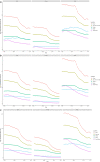
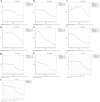
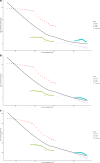
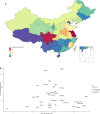
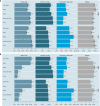

Similar articles
-
Burden of esophageal cancer between 2010 and 2019 in Asian countries by geographical region and sociodemographic index: A comparison with global data.Thorac Cancer. 2023 Aug;14(24):2361-2407. doi: 10.1111/1759-7714.15026. Epub 2023 Jul 17. Thorac Cancer. 2023. PMID: 37455657 Free PMC article.
-
A comparative study of the disease burden attributable to PM2.5 in China, Japan and South Korea from 1990 to 2017.Ecotoxicol Environ Saf. 2021 Feb;209:111856. doi: 10.1016/j.ecoenv.2020.111856. Epub 2021 Jan 4. Ecotoxicol Environ Saf. 2021. PMID: 33412383
-
Temporal trends of tracheal, bronchus, and lung cancer between 2010 and 2019, in Asian countries by geographical region and sociodemographic index, comparison with global data.Thorac Cancer. 2023 Jun;14(18):1668-1706. doi: 10.1111/1759-7714.14912. Epub 2023 May 1. Thorac Cancer. 2023. PMID: 37127553 Free PMC article.
-
The incidence, mortality and disease burden of cardiovascular diseases in China: a comparative study with the United States and Japan based on the GBD 2019 time trend analysis.Front Cardiovasc Med. 2024 Sep 18;11:1408487. doi: 10.3389/fcvm.2024.1408487. eCollection 2024. Front Cardiovasc Med. 2024. PMID: 39359640 Free PMC article. Review.
-
Systematic review and meta-analysis of esophageal cancer in Africa: Epidemiology, risk factors, management and outcomes.World J Gastroenterol. 2019 Aug 21;25(31):4512-4533. doi: 10.3748/wjg.v25.i31.4512. World J Gastroenterol. 2019. PMID: 31496629 Free PMC article.
Cited by
-
Effects of population aging on the mortality burden of related cancers in urban and rural areas of China, 2004-2017: a population-based study.Cancer Biol Med. 2022 Mar 2;19(5):696-706. doi: 10.20892/j.issn.2095-3941.2021.0538. Online ahead of print. Cancer Biol Med. 2022. PMID: 35235277 Free PMC article.
-
Epidemiological trends of women's cancers from 1990 to 2019 at the global, regional, and national levels: a population-based study.Biomark Res. 2021 Jul 7;9(1):55. doi: 10.1186/s40364-021-00310-y. Biomark Res. 2021. PMID: 34233747 Free PMC article.
-
Burden of oesophageal cancer attributed to alcohol use in 204 countries and territories, 1990-2019: results from the Global Burden of Disease Study 2019.BMJ Open. 2025 Feb 13;15(2):e086343. doi: 10.1136/bmjopen-2024-086343. BMJ Open. 2025. PMID: 39947819 Free PMC article.
-
Combined score based on plasma fibrinogen and platelet-lymphocyte ratio as a prognostic biomarker in esophageal squamous cell carcinoma.BMC Cancer. 2024 Feb 22;24(1):249. doi: 10.1186/s12885-024-11968-6. BMC Cancer. 2024. PMID: 38389042 Free PMC article.
-
Second-line tislelizumab versus chemotherapy in Japanese patients with advanced or metastatic esophageal squamous cell carcinoma: subgroup analysis from RATIONALE-302.Esophagus. 2024 Apr;21(2):102-110. doi: 10.1007/s10388-023-01040-w. Epub 2024 Jan 19. Esophagus. 2024. PMID: 38240916 Free PMC article.
References
MeSH terms
LinkOut - more resources
Full Text Sources
Medical

